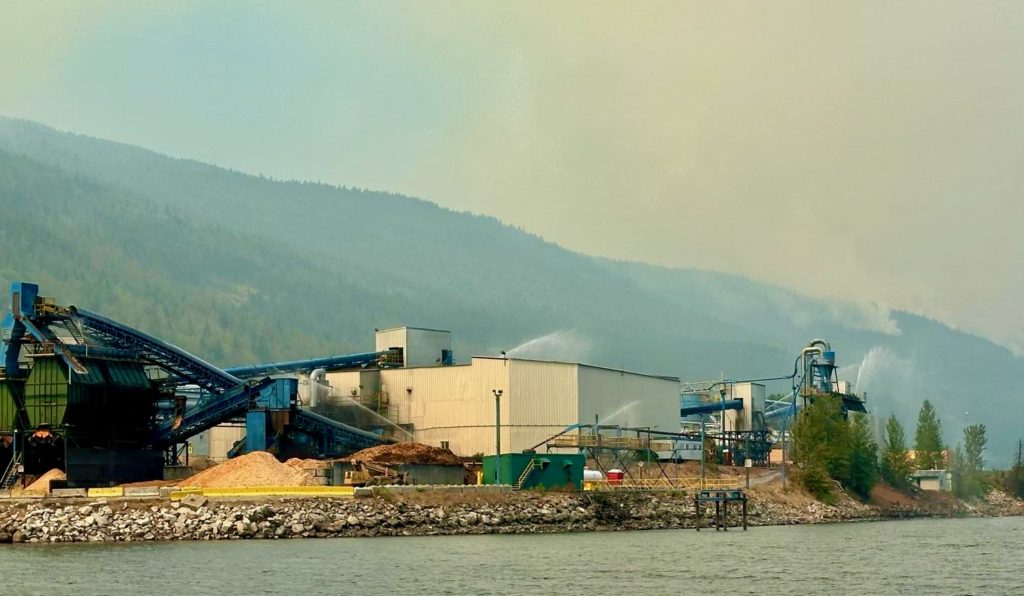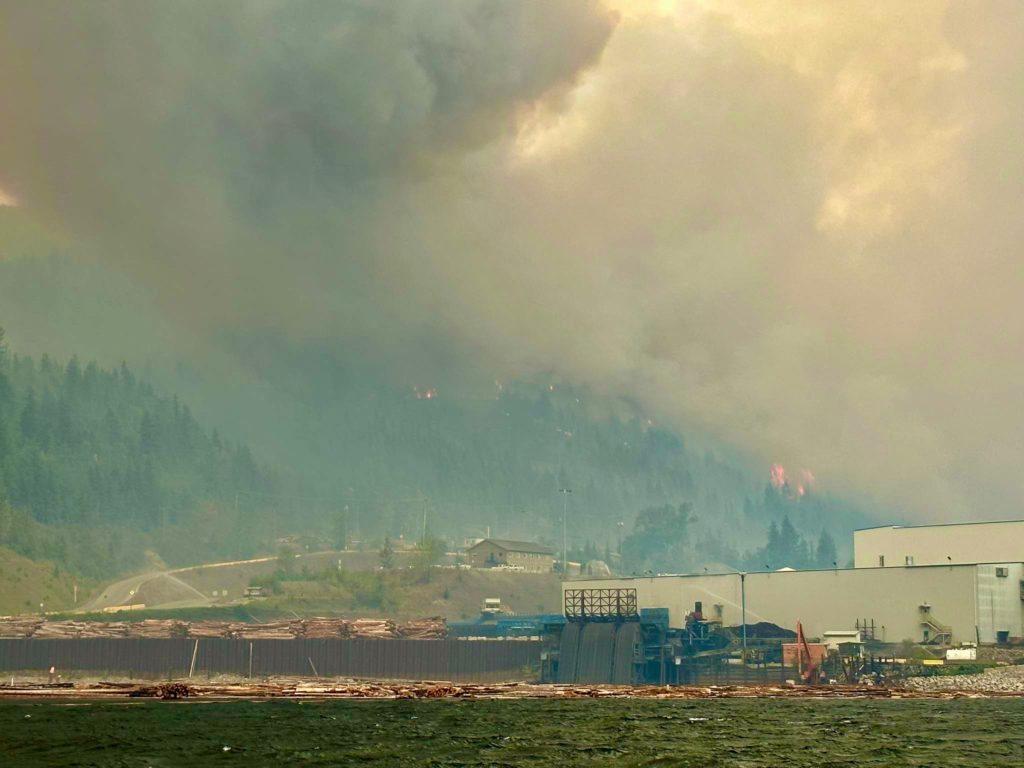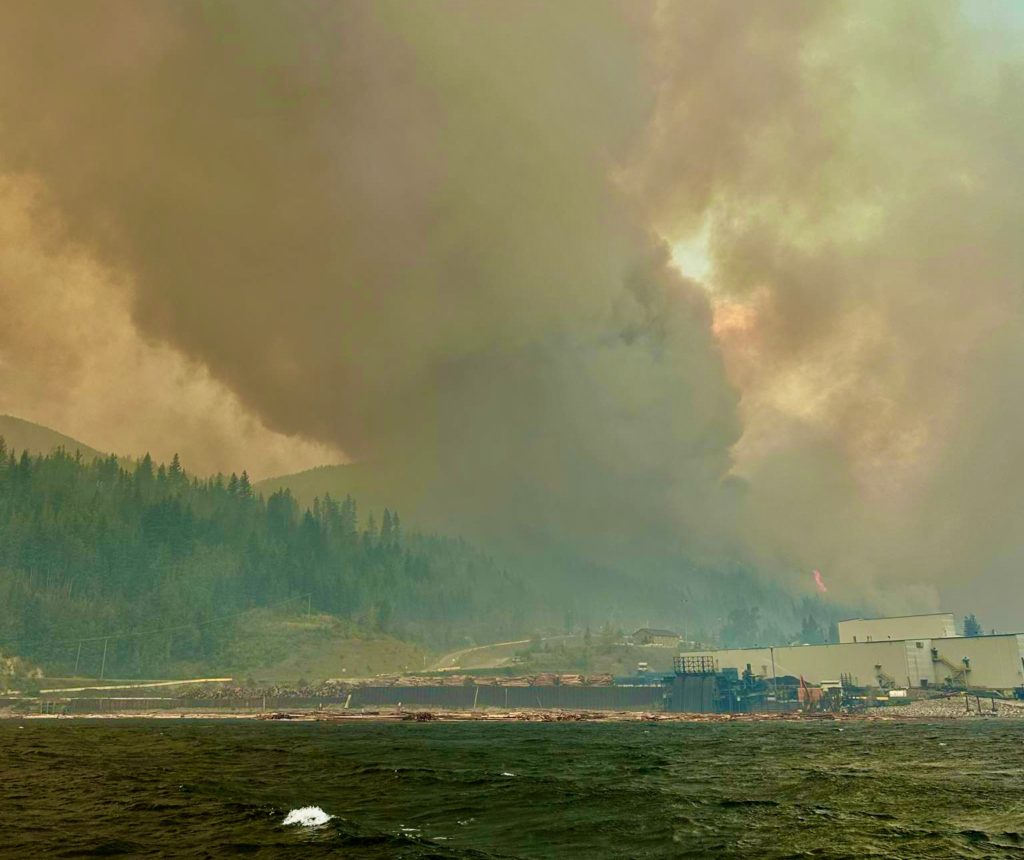
Some people may think that it was a miracle that the Interfor sawmill at Adams Lake survived the firestorm on August 18, 2023, but in reality, it is still operational today because of foresight, much hard work and many thousands of gallons of water. The effort to protect the mill began in 2017 when a lightning strike ignited a fire on the hillside above the mill, which an Interfor team managed to extinguish with shovels, “piss” cans, pumps and hoses that had to be dragged by hand to the fire.
After the 2017 fire, the forestry staff realized how vulnerable the mill was and they began to plan how best to create fire breaks that could protect them during the next fire. Old roads were opened up and the hillside forest was thinned to create a patchwork of clearings and all the debris was piled and burnt. When the firestorm arrived last year, this thinning operation slowed it down as it passed by the mill and helped prevent it from reaching structures.

The Bush Creek wildfire began on July 12th and it continued to grow because not enough resources were deployed in the first few days. Some local contractors requested to action it because it was accessible and close to cutblocks and roads, but the BC Wildfire Service denied their help and insisted that they had the situation under control. Fire breaks were built to prevent it from moving south, but these were not defended after dark and the fire crossed over when the winds kicked up.
As the fire grew closer, the mill staff began to actively protect the valuable industrial site. Fuel reduction was key, so log deliveries were halted and the inventory of logs on dry land was utilized. Most of the lumber was shipped out along with all the hot fuel and shavings, so that the mill yard was nearly empty.
It takes a massive “water dome” to protect a sawmill and this was accomplished with 20 giant water cannons, along with over 70 sprinklers attached to all the structures. The water came from the lake via one very powerful pump powered by a diesel generator. They called the millsite a “rainforest,” because their Kestrel weather meters showed lower temperatures and much higher humidity than the surrounding area.
A fire guard was built just north of the mill that they called the “palisades,” and their plan was that if it was breached by the fire, then everyone would have to leave the mill except for five workers. Woods manager, Erik Kok remarked that on the morning of the 18th as the fire moved south it felt like “they were standing on the great wall of China sharpening our spears as the Huns were getting closer and closer.”

When the fire breached the “palisades” the evacuation order was given and everyone drove out, including the crews who had brought trailers full of structural protection gear to protect the neighbourhood, which had to be left in the parking lot because there was no time to install the pumps and hoses. The five workers who remained included a millwright, an electrician and three managers whose primary job was to keep the pump and the sprinklers working. Their escape plan was to jump in a boat and head out across the lake, which fortunately they never had to do.

The wildfire burned thousands of hectares of forest, including a significant amount of timber within the Interfor Mill’s operating area. As their logging operation shifts to salvage logging, they would like to also focus on making the unburnt forest more resilient to fire through fuel reduction work. They also plan to improve their fire suppression capabilities so they can do a better job of fighting future fires. Last year, their crews were focused on preventing the East Adams Lake fire from moving north and their efforts were largely successful.

Interfor’s mill at Adams Lake is the second largest sawmill in the province. Protecting it was key to the local economy as it ensured that hundreds of jobs remained secure. As the climate continues to heat up causing more fires, it will be imperative that forestry operations be directed to protect communities. As well, when wildfires approach, we now know how important it will be to create moisture domes for defending neighbourhoods.
POSTSCRIPT
August 18th video by Matt Zimmer:
Last year proved how moisture domes can protect structures and entire neighbourhoods. At Adams Lake, the dome moved the fire to the west and thus it also helped save the neighbourhood below the mill. A moisture dome created by sprinklers on a property at the end of Meadow Creek Road shifted the fire into the hills and thus saved all the homes in Meadow Creek valley. In Scotch Creek, water cannons set up by a contractor, Fire and Flood, helped protect the eastern end of the community.

Learn more: Case Study: The effect of a high-volume water delivery system on a fire run from the Bush Creek East Wildfire at the Scotch Creek Community, B.C. August 18th, 2023 – click here
Report conclusion:
The water delivery system established by Fire & Flood Emergency Services, Ltd on August 18th halted the direct impingement of a Intensity Class 4-6 wildfire approaching the Scotch Creek Community from the north and west. The 3 km long system was established in 10 hours and delivered 1.6M liters of water over the one hour run time it ran before fire impingement. While the downwind impacts of this protection are less clear it is likely that the system played a substantive role in protecting the areas to the south and east of the primary protection area.
The plan for sprinkler set-up in Scotch Creek:







